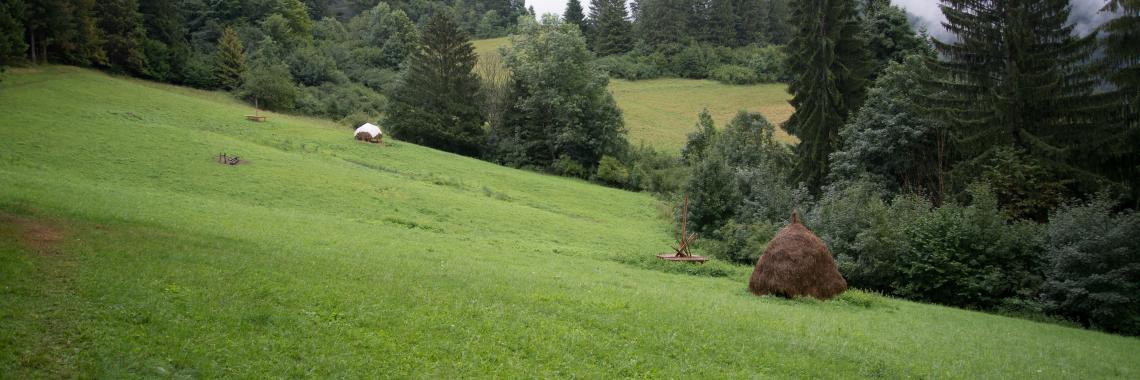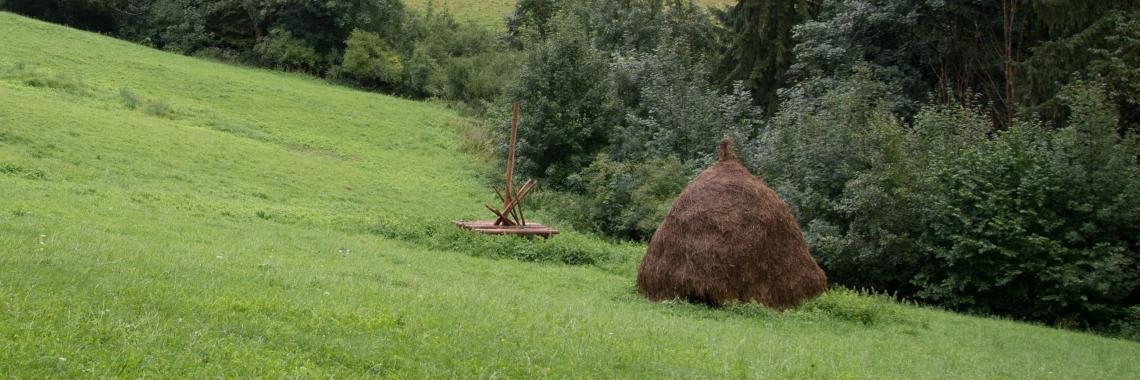Hay making structures in Slovakia
28.09.2017, by Bénédicte Gaillard
Research: Martina Slámová, Jana Špulerová, Marta Dobrovodská, Dagmar Štefunková; upload: Bénédicte Gaillard. The entries are still in process.
Hay is grass, legumes, or other herbaceous plants that have been cut, dried, and stored for use as animal fodder, particularly for grazing animals such as cattle, horses, goats, and sheep.
Hay can be used as animal fodder when or where there is not enough pasture or rangeland on which to graze an animal, when grazing is unavailable due to weather (such as during the winter) or when lush pasture by itself is too rich for the health of the animal. It is also fed during times when an animal is unable to access pasture, such as when animals are kept in a stable or barn.
Specific geographical components - different types of haymaking structures in regions.
Podolák, J.: Pestovanie poľnohospodárskych plodín a chov hospodárskych zvierat na Slovensku od polovice 19. do polovice 20. storočia. In: Agrikultúra 4/1965, 29-77.
Urbancová, V.: Poľnohospodárstvo a chov dobytka. In: Slovensko - Ľud II. časť. Bratislava 1975, 755-800.
Web link: Bill Tarkulich, 2013. Hayricks (oborohy, abora). Slovakia Genealogy Research Strategies. Available at: http://www.iabsi.com/gen/public/hay_ricks.htm
Balázsi, Á., 2018. Grassland management in protected areas – implementation of the EU biodiversity strategy in certain post-communist countries. Hacquetia, 17 (1): 73-84. https://www.degruyter.com/downloadpdf/j/hacq.2018.17.issue-1/hacq-2017-…
Špulerova, J., Dobrovodska, M., Štefunkova, D., Piscova, V., Petrovic, F.. Evolution of the traditional agricultural landscapes of Slovakia. In Environment and ecology in the Mediterranean region II. - Newcastle: Cambridge Scholars Publishing, 2014, p. 133-145. ISBN (10): 1-4438-5538-3,: 1-4438-5538-3, (13. Available online: http://www.c-s-p.org/environment-and-ecology-in-the-mediterranean-regio…)
Jongepierová, I., Mitchley, J. & Tzanopoulos, J. 2007. A field experiment to recreate species rich hay meadows using regional seed mixtures. Biological Conservation, 139 (3–4): 297–305. https://doi. org/10.1016/j.biocon.2007.07.026
http://www.vlkolinec.sk/vsk/menu/zvyky/leto-kosenie-a-susenie-sena-v-li…-
http://www.ludovakultura.sk/index.php?id=4355
http://www.niznaboca.sk/obec/historia/lucne-hospodarenie/
Špulerová, J., Dobrovodská, M., Izakovičová, Z., Kenderessy, P., Štefunková, D., Petrovič, F., 2014. Developing a strategy for the protection of traditional agricultural landscapes based on a complex landscape-ecological evaluation (the case of a mountain landscape in Slovakia). Moravian Geographical Reports, 21(4), 15-26, 10.2478/mgr-2013-0017
Važanová, J. 2009. Trávnice. Lúčne piesne na Slovensku: Ku genéze, štruktúre a premenám piesňového žánru [Trávnice. The Meadow Songs in Slovakia: A Contribution to the Origins, Structure, and Transformations of a Song Genre]. The World of Music, 51 (2): 162–165. www.jstor.org/stable/41699894.
ŠPULEROVÁ, J. DOBROVODSKÁ, M., DAVID, S., HALADA, Ľ., GAJDOŠ, P., 2016. Ecological and cultural diversity of traditional mountain agricultural landscape: A case study from Slovakia. In Biocultural diversity in Europe. 5. Environmental history. - Cham : Springer Innternational Publishing Switzerland, 2016, p. 269-283. ISBN 978-3-319-26313-7. http://www.springer.com/series/10168
Vlkolínec 2012 (Bitušíková. 2014)
Bitušíková, A. 2014. Cultural heritage and globalisation: A story of one UNESCO World Heritage Site, The Central European Journal of Social Sciences and Humanities, 2(1), 9-18.
extensive farming, usually as a part of a mixed system
Present state of meadows - hay making structures preserved only in certain region
traditional meadows: occurence in the areas of dispersed settlement, orchards meadows, terraced landscapes, grassland-pastures landscapes, etc. ..
As a result of collectivization of agriculture and mechanisation development, the traditional „ostrva“ were gradually replaced by factory-made hay bales.
Classification of traditionally mowed meadows in terms of species composition and ecological requirements: 1. wet meadows, 2. Mesophilic meadows (including orchard meadows), 3. dry meadows.
Meadows in the past were situated on the floodplains of major rivers and streams in mountain and foothill areas on less fertile soils or less accessible areas unsuitable for arable land.
Traditionally managed meadows preserved especially in mountainous and foothill areas up to 1100 m., unsuitable for land reclamation to fields or intensively-managed meadows during collectivization, on shallow soils, higher slope – unsuitable for new mechanism. They occurs in the areas close to settlement or dispersed settlement, like orchards meadows, as narrow parcels on terraces, or form grassland-pastures landscapes, etc.
Wet meadows on floodplains in the lowlands and valleys have been preserved only as fragments, often as legislative protected areas, mostly kept within the management of nature and landscape.
Mountain meadows of 1200 m asl were created usually in mountain region with meadows and pasture traditions (heritage of Wallachian colonisation).
Management: according to the quality of the hay meadow – they are mown 1-2 times a year and occasionally grazed, or combination - 1x mowed, grazed.
it is a shrinking usually replaced by new modern technology, exception – region with extreme natural condition
Main treats: conversion to arable land, drainage, construction or abandonment.
Hay making structures preserved only in certain region, with extreme natural condition, not suitable for heavy machine. They are often replaced by mechanisation and the hay is stored like hay rectangular or round bales.
In the White Carpathians important areas were purchased by nature conservation authorities and restored to species-rich hay meadows – being transformed in arable land during collectivization (Jongepierová et al. 2007).
Abandonment, followed by fast succession, threatens the semi-natural grasslands in upper areas.
The productive grasslands are managed by cooperatives of local farmers, which were re-established after the communist era. They have no interest, however, to manage the hardly accessible grasslands, especially hay meadows. The cooperatives slowly eliminated small plots and property borders, causing changes in the landscape structure (Balázsi, 2018).
Loft "senník", chalet (koliba, stodôlka, štálik), shed (šopka) - farm building intended for storing hay.
Hayloft were generally one-room wooden buildings with a gabled roof with no ceiling. During the autumn, hayloft lodged shepherds.
Most often located in the meadows - due to their remoteness from the villages of mountainous terrain and lack of roads that would allow transport of dry hay in the village (transported to the village by sled in winter). Farmers could stay overnight and start early in the morning,
other reason to built it out of the village: lack of storage facilities in the village and a fire hazard. e.g. Nižná Boca -The village was so narrow that there was no space for farm-buildings. People stored directly fodder in the meadows on the top floor of stables in which livestock stayed for winter ".
Most of these hay-loft disappeared from the country during the collectivization of agriculture. Today they are very rare in the country - only as separate isolated objects, they are mostly unused, or were rebuilt to the cottage.
”The seminatural meadows comprise small remnants of former mountain hay meadows, which, together with haylofts, retain the typical mountain landscape features existing before collectivisation.” (Špulerová et al., 2014).
barns at farm settlements - for storage hay, they are less used than in the past, mainly due to decline in livestock production. Today they are used for storing agricultural equipment and toolIn the past, hay was stored outside or in wooden haylofts bearing fearures of folk architecture (small houses usually used for seasonal living and livestock housing) and these haylofts or “open-air” haymaking structures situated on meadows influenced the quality of visual landscape positivelly. Currently, hay is stored in mass large capacity wooden of metal buildings which usually influence the quality of visual landscape and landscape character negatively.
Loft „senník“, stodôlka, šopka, štálik, koliba)
farm building intended for storing hay.
Most often located in the meadows - due to their remoteness from the villages of mountainous terrain and lack of roads that would allow transport of dry hay in the village (transported to the village by sled in winter)
lack of storage facilities in the village and a fire hazard.
Hayloft were generally one-room wooden building with a gabled roof with no ceiling.
During the autumn, hayloft lodged shepherds
hay drying and storage
usually occur in landscapes of high cultural values: “High cultural-historical value was designated for mosaics of arable fields and permanent grassland with almost completely preserved forms of traditional use. These traditional landscapes were created by arable crop rotation, traditional hay-making and use of draught animals, and they were mainly located in the most accessible areas near dwellings. Steep slopes and long narrow fields are not accessible to heavy machines and therefore traditional management has been preserved there.” (David et al., 2015).
aesthetic value, inspiration for artists
folklore „travnice“ (see more Važanová, 2009), tradition maintenance
educational value (ethnological, biological, biodiversity information)
biological gene pool, source of biodiversity
historical value, traditional ecological knowledge: Dolný Harmanec, kosienky - using sleigh, called "krne"
especially to rural population
Sometimes are organised festivals focusing on meadows cutting and hay making
Hay meadows were usually extensively managed, rich in biodiversity and represented a part of mixed agricultural system compiled of arable fields, grasslands, orchards etc.
Mosaic mowing represented a fruitful compromise for mechanization and nature conservation. However, abandonment and plant succession still represents a risk for species-rich hay meadows. An applicable solution was land acquisition of protected sites and accession of funds for conservation measures from different sources (e.g. Life, national grants) (Balázsi, 2018).
3 types:
1. three to five meters tall spruce stake with side branches or smooth stake with cross pin;
2. pyramidal stand consisting of more stick horizontally folded battens.
3. Like a small house open-air hay constructions called “oborohy” (Tarkulich, 2013).
Traditional Agricultural Landscapes with hay-making tradition in Slovakia occur mainly in mountainous and sub-mountain regions of Slovakia, originally arising from German, Sholtys, and Wallachian colonization. These colonisations were intended to colonize or settle sparsely populated or depopulated areas of Slovakia (German colonization by colonists mainly from German-speaking countries, especially in the 12th-4th centuries), or colonize uncultivated and cultivated land (Sholtys internal colonization, mainly by the native population, in the 13th-15th centuries) and supplement the mountainous areas settlement (Wallachian colonization by shepherds of Romanian and Ruthenian nationality in the 14th and 15th centuries).
The result of these colonisations was a diverse landscape with a mosaic of grasslands and arable land. In some regions pasturing was spread. Shepherds built their cow barns, chalets, and enclosure sheepcotes. Semi-natural grasslands, which have arisen as a result of colonization and deforestation, were characterized by high species diversity. They presented together with haylofts typical features of a mountain landscape before collectivisation.
Specific geographical components - different types of haymaking structures have been developed from region to region. They also used local names for hay-making structures.















